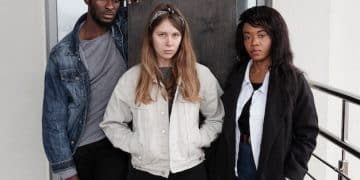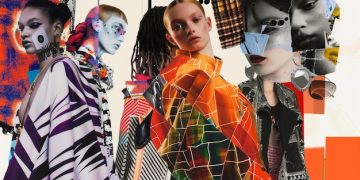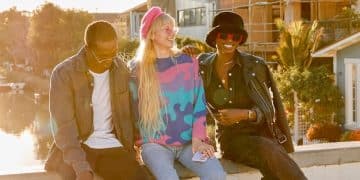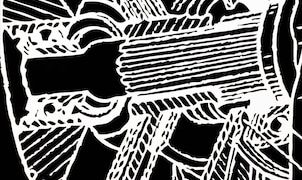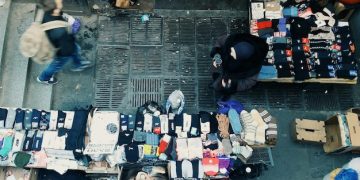Underground Fashion’s Art World Collision: Where Runways Meet Galleries
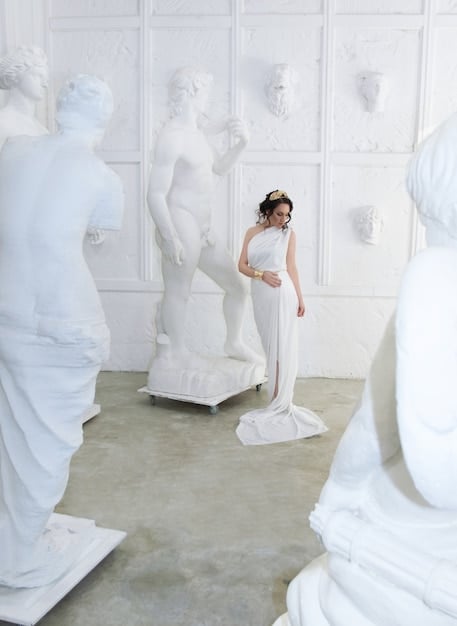
Underground fashion’s art world crossover manifests as a vibrant collision where avant-garde clothing transcends utility, evolving into wearable art that challenges conventional aesthetics and reshapes perceptions of both fashion and artistic expression.
The lines between fashion and art have always been blurred, but the underground fashion’s art world crossover is where this fusion truly explodes. It’s a realm where clothing isn’t just about covering the body; it’s a statement, a canvas, and a rebellion.
The Genesis of Underground Fashion and Art’s Intertwining
Underground fashion, by its very nature, rejects mainstream trends and embraces individuality. When this spirit collides with the art world, it creates a boundary-pushing explosion. This section explores the historical roots of this powerful connection.
The roots of this intersection can be traced back to subcultures and avant-garde movements that thrived on challenging norms and expressing dissent through creative means. From punk aesthetics that repurposed everyday objects into subversive garments to the DIY ethos that valued individuality over mass-produced fashion, underground fashion movements have always been intertwined with artistic intention.
Historical Precedents: Art Movements Influencing Fashion
Several art movements have significantly impacted fashion over the years, particularly in the underground scene. Dadaism, with its rejection of logic and embrace of absurdity, inspired deconstructed designs and unconventional materials. Surrealism’s dreamlike imagery and focus on the subconscious found its way into clothing through distorted silhouettes and unexpected juxtapositions.
DIY Culture and the Rise of Independent Designers
The DIY (Do-It-Yourself) culture, born from punk and other countercultural movements, has been pivotal in fostering the underground fashion scene. It empowered individuals to create their own unique styles, often using unconventional materials and techniques. This DIY ethos spurred the emergence of independent designers who prioritize artistic expression over commercial appeal.
- Punk Fashion: The anti-establishment spirit of punk fueled a raw and rebellious aesthetic, characterized by ripped clothing, safety pins, and DIY customizations.
- Goth Subculture: Goth fashion embraced darkness and romanticism, drawing inspiration from Victorian aesthetics and incorporating elements of literature and art.
- Rave Culture: The vibrant energy of rave culture translated into fluorescent colors, futuristic silhouettes, and experimental materials, reflecting the scene’s emphasis on unity and self-expression.
The convergence of art and underground fashion represents a rebellion against the homogenization of style and a celebration of individual expression. It’s a space where creativity knows no bounds, and clothing becomes a powerful medium for artistic and social commentary.
Key Figures Bridging Fashion and Art in the Underground
The underground fashion scene thrives on innovation, and several key figures have played a critical role in bridging the gap between fashion and art. These designers and artists have redefined the possibilities of clothing and its relationship to artistic expression.
These individuals operate outside the mainstream fashion system, often showcasing their work in unconventional venues like galleries, underground clubs, and independent boutiques. They prioritize artistic integrity over commercial success, and their creations reflect a deep understanding of both fashion history and contemporary art trends.
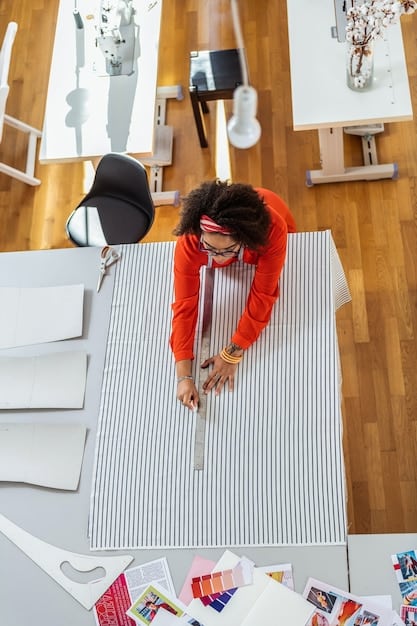
Designers as Artists: The Rise of the Wearable Sculpture
Some designers approach clothing as a form of wearable sculpture, experimenting with unconventional materials and architectural silhouettes. Their creations challenge the traditional definition of fashion, transforming the body into a canvas for artistic expression.
Artists as Designers: Conceptual Art and its Influence on Fashion
Many artists have ventured into fashion design, bringing their conceptual perspectives and artistic techniques to clothing. Their designs often explore themes of identity, consumerism, and social commentary, using fashion as a medium to provoke thought and challenge conventional norms.
- Rei Kawakubo (Comme des Garçons): Known for her avant-garde designs that challenge traditional notions of beauty and silhouette, often exploring themes of deconstruction and asymmetry.
- Alexander McQueen: A visionary designer who infused his runway shows with theatrical drama and dark romanticism, drawing inspiration from historical art movements and subcultures.
- Martin Margiela: A master of deconstruction and anonymity, Margiela’s designs often repurposed vintage garments and challenged the fashion industry’s obsession with celebrity and branding.
These key figures have paved the way for a new generation of designers and artists who are pushing the boundaries of fashion and art. Their work emphasizes the power of clothing as a form of self-expression and a catalyst for social change.
The Role of Subcultures in Shaping the Aesthetic
Subcultures are influential incubators of style. This section explores how various underground movements have profoundly shaped fashion’s landscape and contributed to the artful expressions we see today.
Exploring the contributions of distinct subcultures offers insight into how fashion can operate as a powerful visual language, communicating shared values, beliefs, and identities. From the rebellious spirit of punk to the ethereal beauty of gothic aesthetics, subcultures have consistently challenged mainstream fashion trends and offered alternative modes of self-expression.
Punk, Goth, and Rave: Fashion as a Form of Rebellion
Punk fashion defied societal norms with its deconstructed garments and anti-establishment attitude. Goth subculture brought a dark, romantic aesthetic with Victorian influences. Rave culture vibrantly expressed unity through neon colors and futuristic designs.
Cosplay and Performance Art: Blurring the Lines of Reality
Cosplay transforms individuals into characters, bringing fantasy to life. Performance art utilizes the body as a medium, challenging perceptions of reality and expression. Both challenge the boundary between fashion and reality.
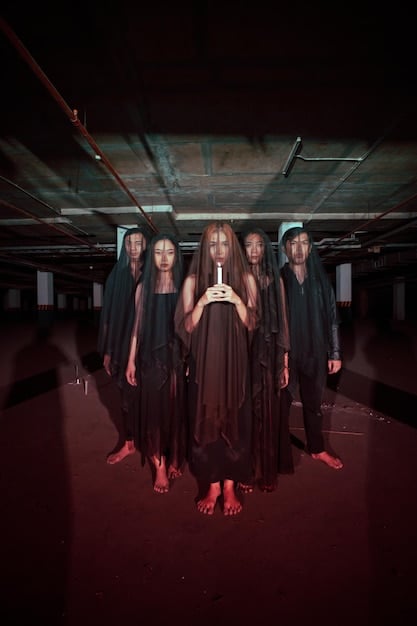
- Steampunk: This subculture blends Victorian aesthetics with futuristic technology, resulting in intricate costumes that showcase craftsmanship and creativity.
- Cyberpunk: Inspired by science fiction, cyberpunk fashion incorporates elements of technology and dystopia, often featuring neon colors, futuristic accessories, and utilitarian garments.
- Lolita Fashion: Originating in Japan, Lolita fashion embraces Victorian and Rococo aesthetics, creating a whimsical and often controversial style.
These subcultures, and countless others, demonstrate the power of fashion to express individual identity and create a sense of belonging. They challenge mainstream trends, inspire creativity, and push the boundaries of what fashion can be.
Underground Fashion as Social Commentary
Beyond aesthetics and individual expression, underground fashion often serves as a potent tool for social commentary. This section will delve into the ways designers and wearers are using clothing to make statements on issues ranging from identity to sustainability.
Exploring fashion as a form of social commentary demonstrates the power of garments to reflect and challenge prevailing social norms. By incorporating political slogans, repurposed materials, and unconventional silhouettes, designers and wearers can express dissent, promote awareness, and advocate for social change.
Challenging Gender Norms and Identity Politics
Underground fashion often disrupts traditional gender roles by embracing gender-fluid styles, deconstructing gendered garments, and celebrating diverse body types. This challenges conventional notions of beauty and empowers individuals to express their identities authentically.
Environmental Activism Through Sustainable Fashion
Many underground designers prioritize sustainability by using recycled materials, upcycling vintage garments, and promoting ethical production practices. Their work raises awareness about the environmental impact of the fashion industry and encourages consumers to make more conscious choices.
- Political Slogans: Designers often incorporate political slogans and imagery into their garments, expressing their views on social and political issues.
- Cultural Appropriation: Underground fashion provides a platform to discuss and address issues of cultural appropriation, promoting respect for diverse traditions and artistic expressions.
- Body Positivity: Many designers embrace body positivity by creating clothing that celebrates diverse body types and challenges unrealistic beauty standards.
By using fashion as a medium for social commentary, underground designers and wearers are sparking conversations, challenging norms, and inspiring change. They demonstrate the power of clothing to be more than just aesthetically pleasing – it can be a catalyst for social progress.
The Impact of Technology on Underground Fashion
Technology continues to reshape nearly every aspect of modern life, and underground fashion is no exception. Let’s explore the innovative ways technology is influencing design, production, and distribution in this realm.
Examining the intersection of technology and underground fashion highlights the evolving nature of creative expression and the potential for innovation within the industry. From digital design tools to 3D printing and online platforms, technology is offering new avenues for designers and wearers to experiment, collaborate, and connect with like-minded individuals.
3D Printing and Wearable Tech: The Future of Fashion?
3D printing allows designers to create intricate and customized garments, pushing the boundaries of wearable art. Wearable tech integrates technology into clothing, offering new possibilities for functionality and expression.
Digital Design and Online Communities
Digital design tools empower designers to experiment with new shapes, textures, and patterns. Online platforms foster communities of like-minded individuals, enabling collaboration and knowledge sharing.
- AR and VR: Augmented reality (AR) and virtual reality (VR) are revolutionizing the fashion experience, allowing consumers to virtually try on clothes and experience immersive runway shows.
- Social Media: Social media platforms provide a powerful tool for underground designers to showcase their work, connect with customers, and build their brand.
- E-commerce: E-commerce platforms have made it easier for independent designers to sell their creations directly to consumers, bypassing traditional retail channels.
The integration of technology into underground fashion is fostering innovation, expanding creative possibilities, and democratizing access to fashion. It allows designers to experiment, connect with audiences, and challenge the established norms of the industry.
Navigating the Underground Fashion Scene: Resources and Communities
For those looking to dive deeper into the world of underground fashion, this section provides guidance on where to find inspiration, connect with fellow enthusiasts, and support emerging designers.
Discovering the best resources and networks makes it effortless to engage with and explore underground fashion. Whether you’re seeking independent boutiques, online communities, or avant-garde fashion events, there are accessible avenues for immersing yourself in this dynamic and experimental world.
Independent Boutiques and Online Marketplaces
Independent boutiques showcase unique and emerging designers. Online marketplaces provide a digital platform for independent designers to sell their creations directly to consumers.
Fashion Blogs and Online Communities
Fashion blogs offer insights into underground trends and designers. Online communities build connections between like-minded individuals, creating spaces for idea sharing and collaboration.
- Fashion Weeks: Alternative fashion weeks often showcase the work of emerging and underground designers.
- Art Galleries: Some art galleries feature fashion exhibitions that explore the intersection of fashion and art.
- Museums: Museum exhibitions dedicated to fashion provide historical context and showcase the evolution of style.
By exploring these resources and communities, individuals can immerse themselves in the rich and diverse world of underground fashion. They can discover new designers, connect with fellow enthusiasts, and support the growth of this innovative and boundary-pushing scene.
| Key Concept | Brief Description |
|---|---|
| 🎨 Art Influence | Art movements inspire designs, blending aesthetics and creativity. |
| 🧑🤝🧑 Subcultures | Subcultures shape aesthetics, fueling fashion innovation and experimentation. |
| 📢 Social Commentary | Fashion as a medium delivers social messaging and challenges norms. |
| 💻 Tech Impact | Technology advances shape creativity, production, and access to fashion. |
FAQ
Underground fashion defies mainstream trends, embracing individuality and unique styles. This often means incorporating unconventional materials, recycled garments, and DIY customizations to express distinct identities.
Art movements influence fashion by inspiring designers to experiment with colors, shapes, and themes. Dadaism inspires deconstruction, while Surrealism brings dreamlike imagery, enhancing creative expression in design aesthetic.
Subcultures significantly shape fashion trends by promoting their unique styles and values. Punk, Goth, and Rave scenes demonstrate how these movements create diverse aesthetics and influence mainstream fashion with specific attributes.
Technology transforms underground fashion through 3D printing, digital design, and wearable tech that provide new possibilities for innovation. Social media and e-commerce enhance accessibility, supporting designers and enabling unique expression.
Discover unique underground fashion by exploring independent boutiques, online marketplaces, and fashion blogs focused on emerging designers. Immersing yourself in these resources, cultivates a greater appreciation for boundary-pushing style.
Conclusion
The underground fashion’s art world crossover isn’t just a trend; it’s a dynamic and evolving movement that reflects our desire for individuality, social commentary, and creative expression. By embracing the unconventional, challenging norms, and blurring the lines between fashion and art, this movement is shaping the future of style and culture.
